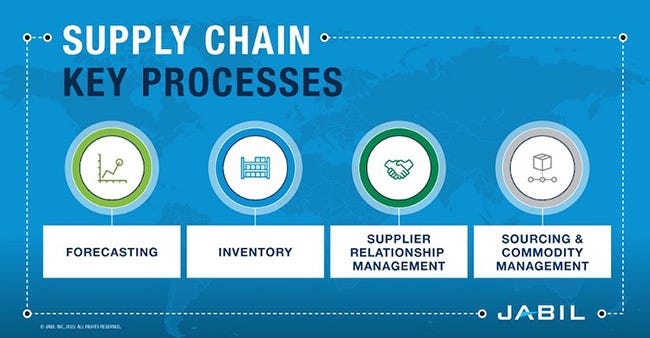Increasingly complex global supply chains, climate change, and geopolitical events will lead to more disruption. Here’s how businesses can effectively adapt to the new normal.
June 5, 2023

Supply chain resilience is important — nay, critical — because supply chain disruptions have always happened and will keep happening. Before the COVID-19 pandemic in the early 2020s, on average, companies experienced a one- to two-month disruption every three and a half years or so. During the pandemic, new disruptions seemed to pop up daily.
In the new normal, manufacturing services company Jabil expects that disruptions will happen at least as often as they did pre-pandemic, if not more often. These increasing disruption rates can be attributed to increasingly complex global supply chains; more frequent inclement weather related to climate change; geopolitical events that can disrupt lengthy supply chains; and other challenges that will ultimately arise as a result of developing markets, products, and technologies. Although many of these events are beyond any one company's control, companies can regain some leverage by building their supply chain resilience, according to Jabil. Detailed strategies are highlighted in the company’s report titled, “Global Supply Chain Readiness Report: The Pandemic and Beyond.”
|
Establish supply chain resilience
Supply chain resilience is defined as a company’s ability to navigate unexpected supply chain disruptions with existing capabilities. In other words, supply chain resilience is the ability to react to problems and recover from them without significant impact to operations or customer timelines.
When disruptions do occur, they can be catastrophic not only for operational excellence and employee morale but for the company's bottom line. Supply chain disruptions can cost an organization 45% of a year's profits throughout the course of a decade.
One of the hallmarks of supply chain resilience is change, according to the Jabil report. Building supply chain resilience requires changing and updating processes and practices to address current challenges. But this is not a one-and-done project. As the world and global markets evolve, supply chains also must continue changing to keep up with them. And as new challenges arise, companies need to adjust their supply chain resilience plans to stay ahead of upcoming risks. For now, this means that companies need to make changes to their approaches to the three core enablers of supply chain resilience — processes, people, and technology.
In terms of processes, Jabil stresses the importance of end-to-end supply chain visibility to peer into the demand and risk forecasts for their supply chain partners. Most practically, it helps to know about current lead times for one’s suppliers and what risks might cause interruptions and delay that timetable. One supplier’s challenge can have ripple effects across the rest of the supply chain, causing each subsequent link to experience delays and fail to meet forecasts.
Carry more inventory
Inventory management is also a critical process. For years, a best practice for inventory management has been a just-in-time approach. The idea is that an organization or facility carries enough stock to meet demand — known as cycle stock — plus some buffer stock to cover demand surges, production interruptions, or operational delays. Carrying more than that means you are unnecessarily tying up capital and space in stock that you don't need in the near future. However, in an age of supply chain disruptions and longer lead times, companies need to shift to a more conservative inventory management strategy that includes more buffer stock.
Improve market visibility with real-time analytics
Technology can help employees complete the above-mentioned processes more easily and accurately and allow organizations to bolster their supply chain resilience by staying ahead of challenges and trends, according to Jabil. For example, real-time analytics and decision-support tools, including enterprise resource planning and electronic data interchange platforms, can help provide baseline data, which, in turn, justify investments in spend, supplier, and commodity analyses. Together, these enriched data sets can help managers better understand the dynamics of the procurement process; make decisions related to customer needs, production schedules, logistics, and delivery requirements; anticipate upcoming challenges, including shortages; and respond quickly to market shifts.
About the Author(s)
You May Also Like





